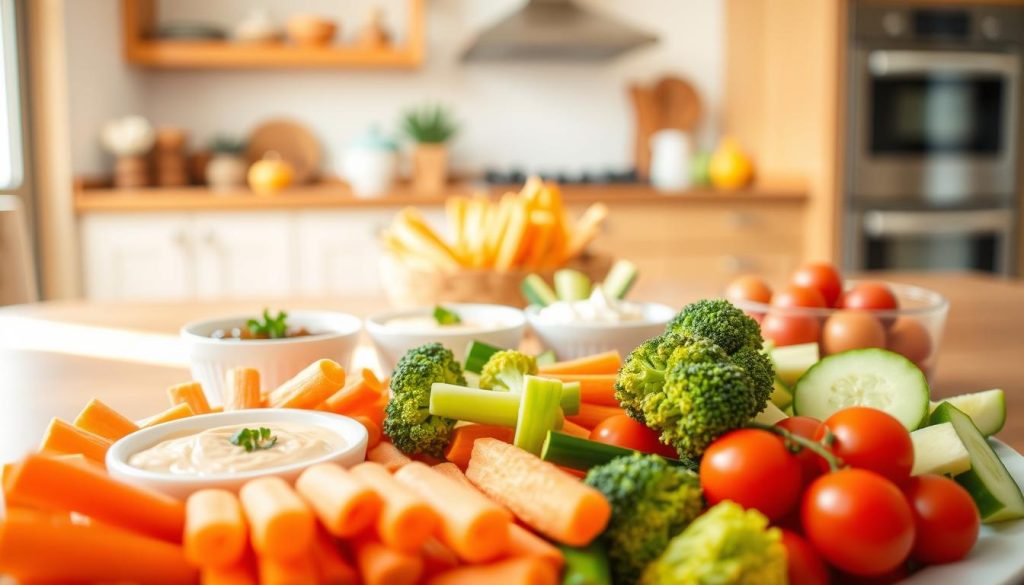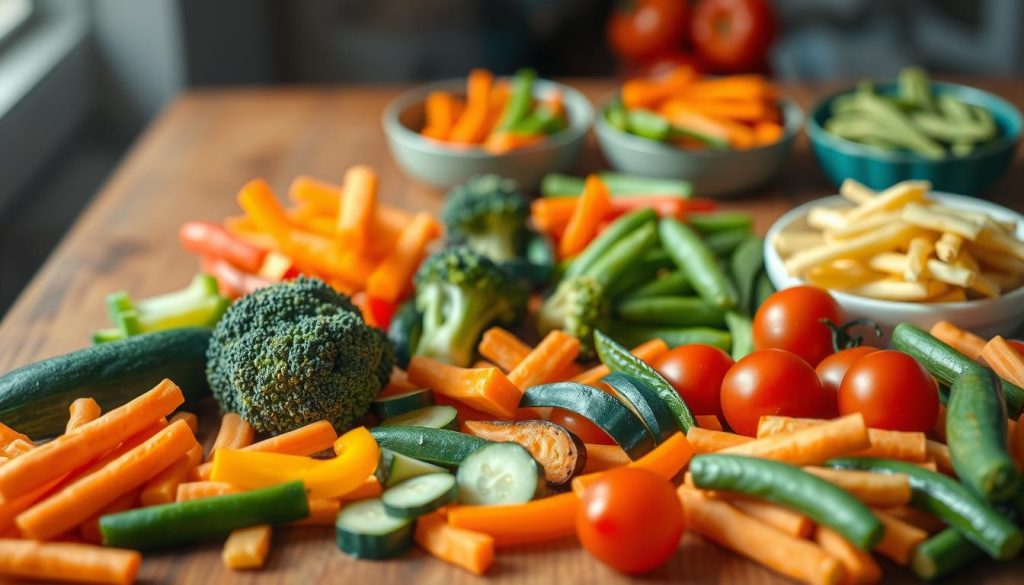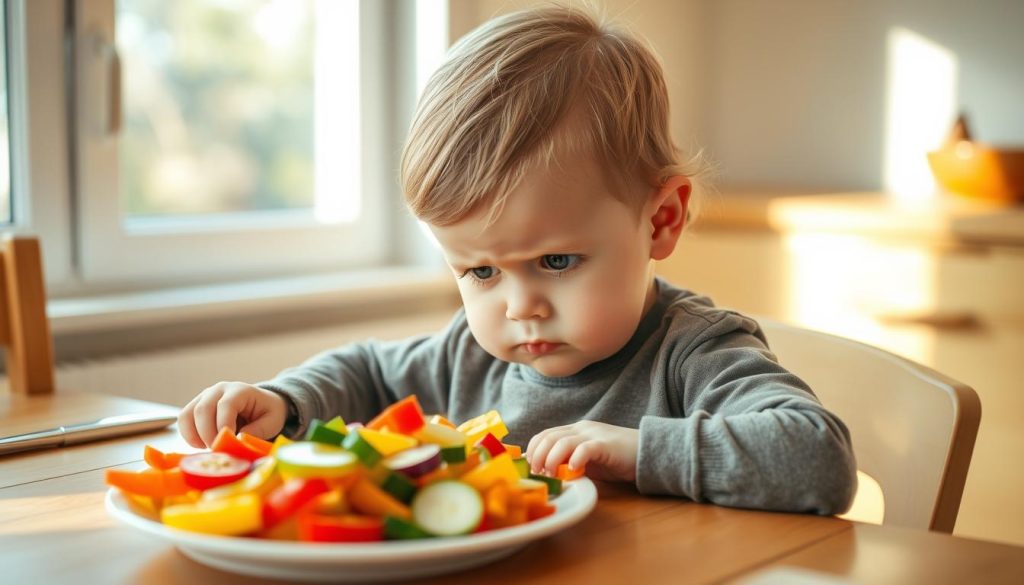
Getting toddlers to eat their veggies can feel like an impossible mission—trust me, I’ve been there! One day, they love carrots, and the next, they act like you’re trying to poison them.
As moms, we all want our little ones to enjoy healthy food, but picky eating (especially when it comes to vegetables) can make mealtime a daily battle.
That’s why I’ve put together 12 life-changing toddler veggie ideas that have worked wonders in my home. From sneaky ways to hide veggies in their favorite meals to fun and creative recipes, these tips will help make veggies a regular part of your toddler’s diet—without the tantrums.
Ready to turn those veggie struggles into wins? Let’s dive in!
Key Takeaways
- Consistent exposure (10–15 tries) helps kids accept new veggies.
- Incorporate veggies into familiar foods like soups or muffins to boost acceptance.
- Involve toddlers in cooking to increase willingness to try vegetables.
- “Eating the rainbow” ensures diverse nutrients through colorful fruits and veggies.
- Smoothies can sneak in nutrients—just 5 minutes of prep delivers vitamins like Vitamin A and C.
Why Toddlers Refuse Vegetables (And Why It’s Normal)
If your toddler pushes away their veggies or makes a dramatic gagging face at the sight of anything green, you’re not alone! Most toddlers go through a picky eating phase, and veggies are often the first thing they reject.
But before you worry, know that it’s completely normal. Here’s why:
- Natural taste preferences – Toddlers are wired to prefer sweet flavors over bitter ones, making veggies less appealing than fruits or carbs.
- Fear of new foods (neophobia) – Many toddlers are cautious about unfamiliar foods, and veggies often fall into that category.
- Texture sensitivity – Some veggies have strong textures (mushy, crunchy, or stringy), which can be overwhelming for little ones.
- Desire for independence – At this stage, toddlers love testing boundaries, and refusing food is one way they assert control.
- Negative past experiences – If they’ve had a bad experience with a certain veggie (like an overcooked, mushy carrot), they may refuse it altogether.
- Lack of exposure – It can take multiple attempts before a toddler accepts a new food. If they don’t see veggies often, they’re more likely to reject them.
- Parental pressure – The more we push, the more they resist! If they sense stress around eating veggies, they may instinctively say no.
The good news? This phase won’t last forever! With patience, creativity, and a few clever tricks, you can help your toddler develop a love for veggies over time.
The Benefits of Maximizing these Toddler Veggie Ideas

Finding creative ways to include vegetables for toddlers isn’t just about avoiding mealtime battles—it’s about setting them up for a lifetime of healthy eating. By using these toddler veggie ideas, you can help your little one develop a love for healthy food for toddlers while making mealtime stress-free.
Here’s why it’s worth the effort:
- Boosts Nutrition – A diet rich in vegetables for toddlers ensures they get essential vitamins and minerals for growth, brain development, and overall health.
- Encourages a Balanced Diet – The more variety they eat now, the less likely they’ll become a picky toddler who refuses healthy foods.
- Promotes Healthy Digestion – Many vegetable recipes for kids include fiber-rich foods that help prevent constipation and keep little tummies happy.
- Makes Mealtime Easier – Fun and tasty veggie snacks for kids can reduce food battles and make eating vegetables something to look forward to.
- Supports a Strong Immune System – A well-balanced diet with vegan toddler meals and plenty of veggies can help fight off colds and infections.
- Develops a Lifelong Love for Veggies – Early exposure to toddler vegetables increases the chances of kids enjoying healthy foods as they grow.
- Encourages Creativity in the Kitchen – Trying new hidden vegetable recipes keeps meals exciting and helps even a picky toddler become more adventurous with food.
By using these vegetarian toddler meals and smart ways to sneak vegetables into food for kids, you’ll make veggies a natural and delicious part of your child’s diet—without the fuss!
12 Life-Changing Ways to Get Your Toddler to Eat Veggies

Getting a picky toddler to eat vegetables can feel like an impossible task. Trust me, I’ve been there—watching my little one push away a plate of perfectly cooked broccoli with a dramatic “yuck!”
But don’t worry, there are so many creative ways to make veggies fun, tasty, and totally toddler-approved. From sneaky veggie hacks to turning mealtime into a playful experience, these tried-and-true methods will help your little one develop a love for vegetables—without the mealtime battles!
1. Make Veggies Fun with Shapes and Colors
Toddlers love anything fun and playful, so why not make veggies exciting? Try using cookie cutters to turn carrots, cucumbers, or bell peppers into stars, hearts, or animals.
A colorful plate is also more appealing—mix kid-friendly vegetables like red bell peppers, yellow corn, and green peas to create a rainbow effect. You can even arrange veggies into smiley faces or animals on their plates.
When veggies look fun, toddlers are more likely to give them a try. Making mealtime a creative experience can turn their curiosity into excitement, making vegetables for toddlers a regular part of their diet.
2. Sneak Veggies into Their Favorite Foods
If your toddler refuses to eat veggies outright, don’t worry—you can sneak them into meals they already love! Blending vegetables for toddlers into pasta sauces, soups, or smoothies is a great way to boost nutrition without them noticing.
Try adding puréed carrots to mac and cheese, mixing spinach into scrambled eggs, or baking hidden vegetable recipes like zucchini muffins. Another trick is to use finely grated veggies in picky toddler meals like meatballs or burgers.
This way, they get all the nutrients without any fuss, and mealtime stays stress-free for both of you.
3. Get Your Toddler Involved in Cooking
Toddlers love to feel independent, and involving them in meal prep can make them more open to trying new foods. Let them wash veggies, tear lettuce, or mix ingredients for vegetarian toddler meals.
Giving them small tasks helps them feel a sense of ownership, making them more likely to eat what they helped prepare. You can also take them grocery shopping and let them pick out a new veggie to try.
When they feel involved in the process, they become curious and excited about food, making it easier to introduce healthy food for toddlers into their diet.
4. Offer Veggies in Different Textures
Some toddlers refuse veggies simply because they don’t like the texture. If your little one dislikes mushy peas, try roasting them for a crispy texture. If they avoid raw carrots, try steaming them for a softer bite.
Experimenting with different textures—crunchy, smooth, soft, or crispy—can make a huge difference. Veggie tots for toddlers are another great option because they provide a fun, familiar texture while still being packed with nutrients.
When you serve veggies in a way that matches your child’s preferences, they’re much more likely to eat them without hesitation.
5. Pair Veggies with Tasty Dips
Let’s face it—toddlers love to dip! Pairing toddler vegetables with yummy dips can make them instantly more appealing. Try offering hummus with carrot sticks, guacamole with bell peppers, or yogurt-based ranch dressing with cucumbers.
Even simple peanut butter with celery can make a big difference. The dip adds flavor and makes eating veggies feel more interactive. Plus, dips can provide extra nutrients, like protein and healthy fats.
Having a variety of dips on hand allows toddlers to explore different taste combinations, making them more likely to enjoy veggie snacks for kids without a struggle.
6. Use Positive Reinforcement and Rewards
Toddlers respond well to praise and small rewards, so use positive reinforcement when they try veggies. Instead of pressuring them to eat, celebrate small wins—whether it’s taking one bite of broccoli or finishing a side of vegetarian toddler meals.
A sticker chart or a fun reward (like extra playtime) can encourage them to keep trying. Keep it light and fun—if they feel like they’re winning a game, they’ll be more excited to participate.
Avoid using dessert as a bribe, as this can create an unhealthy relationship with food. Instead, focus on making veggies an enjoyable experience.
7. Create a Routine with Regular Veggie Exposure
It takes multiple exposures before a child fully accepts a new food, so consistency is key! Even if your toddler refuses a veggie today, don’t give up—keep offering it in different ways.
Serve vegan toddler meals with a variety of veggies at every meal, even if they don’t always eat them. Over time, the more they see veggies on their plate, the more familiar and less intimidating they become.
Try offering at least one veggie option with each meal or snack. Eventually, your little one might surprise you by grabbing a bite all on their own!
8. Try Smoothies and Hidden Veggie Drinks
Smoothies are a fantastic way to pack in extra vegetables for toddlers without them even realizing it. Blend spinach, carrots, or zucchini with their favorite fruits like bananas and berries for a naturally sweet and nutrient-rich drink.
A little yogurt or nut butter adds creaminess and extra protein. If your toddler enjoys juices, consider making your own by blending veggies and fruits together instead of store-bought versions. These hidden veggie drinks make it easy to sneak in greens while keeping things delicious and refreshing.
Bonus tip: Give smoothies a fun name like “Superhero Juice” for extra excitement!
9. Make Mealtime a No-Pressure Zone
The more we pressure toddlers to eat veggies, the more they resist. Instead of making it a battle, keep mealtimes relaxed and stress-free.
Offer veggies without forcing them, and let your toddler decide how much they want to eat. Avoid using phrases like “Eat your broccoli, or no dessert” because it makes veggies feel like a punishment. Instead, create a positive environment by letting them explore food at their own pace.
Over time, they’ll feel more comfortable and willing to try toddler vegetables without resistance, making mealtime an enjoyable experience for everyone.
10. Set a Good Example by Eating Veggies Too
Toddlers love to copy what they see, so if they watch you enjoying healthy food for toddlers, they’ll be more likely to eat it too. Sit down together for meals and show enthusiasm when eating your own veggies.
Talk about how yummy they are and describe the flavors in an exciting way. If your toddler sees that veggies are a normal part of your meals, they’ll become more open to trying them.
Family meals also create a sense of togetherness, reinforcing the idea that eating vegetarian toddler meals is something enjoyable, not a chore.
11. Experiment with Different Cooking Methods
Not all veggies need to be served raw or steamed—trying different toddler-friendly recipes or cooking methods can make them much more appealing! Roasting brings out the natural sweetness in carrots, sweet potatoes, and Brussels sprouts, while grilling can add a smoky flavor to zucchini and bell peppers.
Even air frying can make veggie tots for toddlers crispy and delicious. Sometimes, it’s just a matter of finding the right preparation that your toddler enjoys.
Keep experimenting with flavors, seasonings, and cooking styles until you discover their favorite way to eat toddler vegetables.
12. Use Storytelling and Fun Characters
Turn mealtime into an adventure by using storytelling to make veggies more exciting! Tell your toddler that broccoli gives them “superhero strength” or that carrots help them “see like a bunny.”
You can also create fun characters—maybe the cherry tomato is a little bouncy ball that needs a new home in their tummy! When toddlers associate vegetables for toddlers with something fun and imaginative, they’re more likely to give them a try.
You can even name veggie-based meals after their favorite characters—like “Dinosaur Green Smoothie” or “Bunny Carrot Sticks”—to make eating veggies even more enjoyable!
Common Mistakes Parents Make (And How to Avoid Them)

Even with the best intentions, we sometimes make mealtime harder for ourselves—and our toddlers. I know I’ve fallen into some of these traps, thinking I was helping when, in reality, I was making veggies even less appealing.
The key is to create a positive, pressure-free environment where kids can learn to enjoy vegetables at their own pace. Here are some common mistakes parents make and how to fix them:
- Forcing or Pressuring Them to Eat – Making veggies a “must-eat” can backfire. Instead, offer them regularly and let your toddler decide.
- Using Sweets as a Reward – Saying, “Eat your broccoli, and you’ll get dessert” teaches kids that veggies are bad and sweets are good. Try praising their effort instead!
- Serving the Same Veggies the Same Way – Kids need variety! Switch up how you cook and serve veggies to keep things exciting.
- Expecting Instant Success – It can take multiple tries before a toddler accepts a new food. Stay patient and keep offering veggies in different ways.
- Not Eating Veggies Yourself – Toddlers learn by watching! If they see you enjoying your veggies, they’ll be more likely to try them too.
By avoiding these mistakes, you’ll make it much easier (and way less stressful) to get your toddler to eat their veggies!
Conclusion
Getting a toddler to eat vegetables might feel like a never-ending battle, but with a little creativity and patience, it is possible! I’ve learned that making veggies fun, offering them in different ways, and keeping mealtime pressure-free can truly change the game.
The key is consistency—keep introducing vegetables for toddlers in a way that feels exciting and natural, and eventually, they’ll come around.
Remember, every small win counts! Whether it’s a single bite of broccoli or discovering a new favorite veggie snack, celebrate the progress. You’ve got this, mama—happy veggie-eating!




